 |
| View of the Camillia Fields at Gorreana Cha Plantation |
We did stop in some interesting places:
Sete Cidades: (Seven Cities)
 |
| View from Lip of the Caldera |
 |
| The Walls of the Caldera were Lush with Invasives. |
 |
| Note Clouds obscuring rim of Caldera (no looking down from there) |
 |
| Portable or Mobile |
I asked our guide for more technical details.
I look. “You mean inside that green shed?”
“No, it IS the green shed”.
“You said the machines were portable”.
“Yes, that shed has wheels. You can pull it with a tractor”.
Ah.
Websters says that portable is “Small and light enough to be easily carried or moved”.
A cell phone is portable. A folding chair is portable. A car is not portable. Even though it is easy to move around.
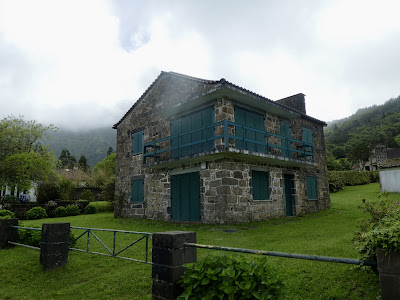 |
| This is either a centuries old farm house or a New Modern Summer home. I forget. |
Making Tea: (Gorreana Tea Plantation)
The factory was pretty neat, they had all of the power that runs the conveyer belts and the shakers and the cleaners and the driers running off of belts and spinning bars like they would have originally done if the factory was run by steam or perhaps by watermill. The guide said that one of the ways that the plantation has stayed open and profitable over the years is that they have their own water source that they use to generate 100% of their own electricity.
The fields of Camellia are very geometric and sized such that the picking machines can be run with wheels down either side of the bushes. Unclear to me exactly how these machines work, I will look for pictures. There were not any out in the fields when we visited. It is the wrong time (either of the year or of the day or of the cycle).
 |
| Power to the factory distributed by belts and wheels. Just like in the water or steam era! |
 |
| A green tea shaker |
 |
| The hedgerows are spaced such that the picking machine can roll down the rows. |
Ginger LIly -
Ginger Lily is everywhere but especially up the hard to get to canyons of the upper volcano slopes. It just covers everything with its 4 foot long stems and broad leaves. I didn't realize what a pest it must be until I saw some of the expanses of it up near Furnas (Furnash).
Our guide told us that there is a new exotic, a Rhubarb, which is expected to be even worse once it takes hold. Perhaps the two plants will slug it out.
 |
| That something rhubarb |
Lago de Furnas –
 |
| Yes, that appears to be boiling water |
Our hike for the day was around the Lago de Furnas, the lake that has formed in the Furnas Volcanic Caldera. To get to the lake, you have to walk a half mile up a steep hill from the town. Yes, the lake is uphill from the town, though both are in the larger structure that could be argued is part of the Furnas Volcano. In the 1600s there was another lake that was in a slightly higher and smaller Caldera, but a large earthquake caused the collapse of a wall of that crater and the water poured down into the Furnas lake. Our guide said that the same thing could happen to the town of Furnas if a large quake or eruption were to disturb the wall of the caldera above the town. Always a little excitement with these tour guides.
We are walking our biggest hike today, almost 7 miles. About halfway were are going to be visiting the Furnas Monitoring station to receive a scientific briefing on the work of the monitoring station. Myself and many of the other peoples on the tour had assumed that the station was monitoring volcanic activity, but this is not the case.
 |
| The lake in the Caldera |
 |
| Lake house |
Centuries of wanton dairy farming have caused great damage to the water quality of the Furnas Lake. The cows and the farming practices that were used introduced a lot of fertilizer and cow excrement and other nutrients into the local streams and these streams all ran down into the lake. These nutrients caused the growth of algae and other small water life which then proceeded to clog and ruin the pretty lake. The lake is currently only about half of its historic depth because there is 20 feet of decayed materials accumulated there. The Acorean government (in what I think is an unprecedented move) decided to take action to reverse this situation. They bought up all of the farm land and moved the farmers to other lands on the other side of the drainage ridge. Then they did a massive effort to clean up the farm land and convert it over to a sustainable and non-destructive silage use. This was a big multi-year effort and required a lot of trash removal. For instance, our scientist informed us, the farmers used to store their silage (ground up corn and/or hay) under large plastic tarps that they would weigh down with old car tires. When they were done with it, they would just leave the tires sitting. The cleanup crew had to remove some 6000 tires (and the lady scientist said she knows because she had to count them in order to pay for their removal). I am guessing that at the time used tires were free because there was no place to recycle them on the island and no place to throw them away (well, I guess there was the sea. Hate to look down there).
The fields were all replanted with many different species of clover. Clover has the following advantages: it fixes Nitrogen from the atmosphere, so it actually enriches the soil, It can be used by local beekeepers to make excellent honey, and it can be harvested and then shipped to the same displaced farmers to use on their new farms as silage. In effect, the scientist having been spending a lot of time and effort to teach the local diary farmers how to do sustainable farming.
 |
| The machine that cleans out (harvests?) the weed like algae |
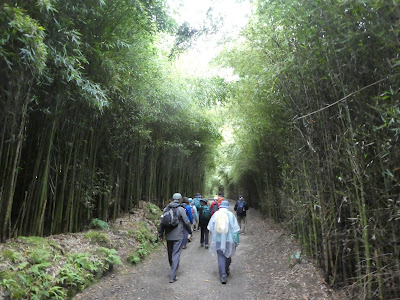 |
| A Bamboo Farm. Invasion? |
 |
| One of many stump carvings along the path |
 |
| Recovering our Lunch |
 |
| One of many public mineral springs |
Have these efforts yielded any good results? Yes, but they are measured in the form of fewer bad things rather than good things. For instance, this year was the first year on decades that there wasn’t a huge algae bloom in the lake. The following is Jon guessing: The lake has a long green plant/weed that chokes the water and makes it dangerous to swim. Our guides keep referring to is as algae. Since our guides have a lot of botany training, I am assuming that they are right and it really is an algae, perhaps somewhat related to giant kelp (another algae). That weed algae is harvested with a big harvesting machine, not sure if the weed is useful for anything other that compost. My assumption is that the algae bloom was another algae, perhaps the blue-green algae that makes poisonous blooms in the Willamette river during some really hot summers.
The goal of this entire process is to reverse the Nitrification of the lake. (OK, I thought our guide said Nitrification, or perhaps Nutrification. But Nutrification isn't a word and Nitrification doesn't make sense (since it only happens under ice in a frozen lake. Some searching comes up with the word: Eutrophication), perhaps eliminate the algae (by starving it). And turn the lake back into a usable recreational resource.
During the hike it struck me that it would be pretty great if we could do that in the states with a similar lake, like perhaps Klamath Lake in southern Oregon. That lake is also choked with weed and algae from all of the farming run-off. It would be pretty hard to buy up all of the farms uphill from that lake, however. Not something that I think the Oregon government has the wherewithal to pull off. It is, perhaps, too much of a forward-thinking project to be expected of Americans. I guess we did really well when we set aside the giant US Parks and Forests in the west of the country (Not soon enough to set aside similar chunks of land in the east).
Geothermal Energy -
Since we are touring around a place that not only has a lot of geothermal energy but has actively been using it for a couple of centuries I thought I would take a moment to talk about the use of Geothermal in modern ways in the Azores. This is the use of Geothermal energy to generate electricity (which our lecture called ‘power’).
We sat in a meeting room at our very nice little hotel in Angra and received a little slide show and lecture from the head of Geothermal in Terceira. She talked about geothermal in general but also about specific uses and amounts in Terceira and Sao Miguel.
My take-aways on this:
There is a thermal gradient from Earth’s Core to the surface. To make efficient use of geothermal energy, you need a large gradient close to the surface. These happen at hot springs and volcanoes. This means that geothermal isn’t for everyone.
Geothermal is not just “let the steam turn the turbine”. It is much more complex and expensive than that. Because of this it is only cost effective in places that have lots of heat and other resources are more expensive (like on an island).
The use of the energy is also dependent on there being groundwater that is being heated and rapped in an underground aquifer.
The Azores wants to have around 50% of their power supply be renewable. They are at around 42% right now and most of that is Geothermal.
The amount of Geothermal energy you can get out of a site is calculable. You can’t get more than that out without diminishing the resource.
It is difficult to quickly increase or decrease the power coming out of a geothermal generator. This means that this method is good for a base layer power as opposed to ‘on demand’.
The very hot steam and water that comes out of the ground is chock loaded with caustic salts and chemicals. It cannot be used directly for power generation. Instead, it is used to heat a special liquid (not water) that is then used to spin the turbines in a closed loop system. The caustic steam and water are cooled in this process and then injected back into the ground. They do this for reuse but I suspect they also do it because they don’t want to dump all of the brine on the land and poison it.
In Terceira, they are just about at full usage for the resource they have available. If they try to generate more power they will cool things off too much to work.
A field trip to the facility would have been fun. <hint hint>
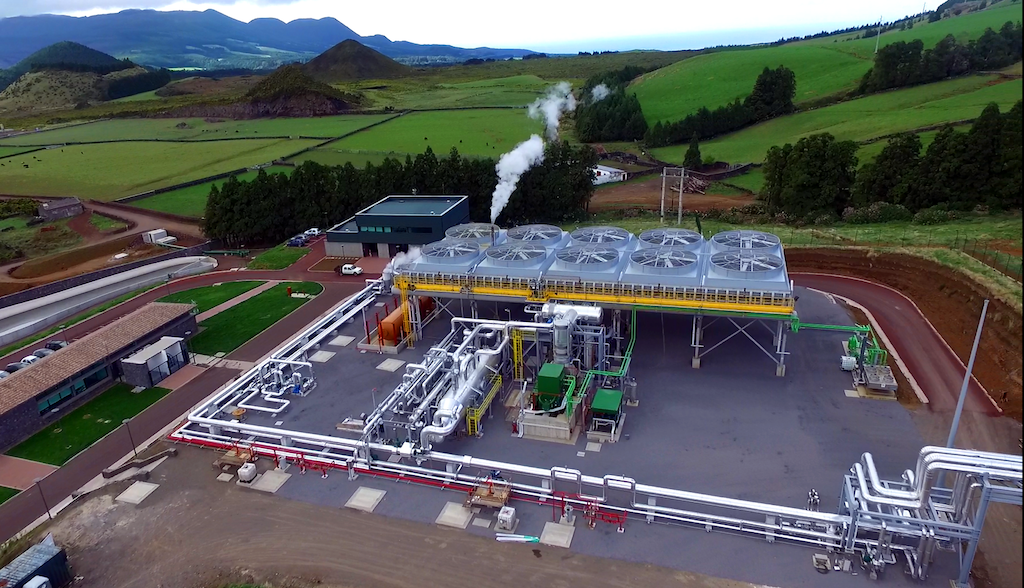 |
| Terceira Geothermal Plant Image Stolen from Interwebs |

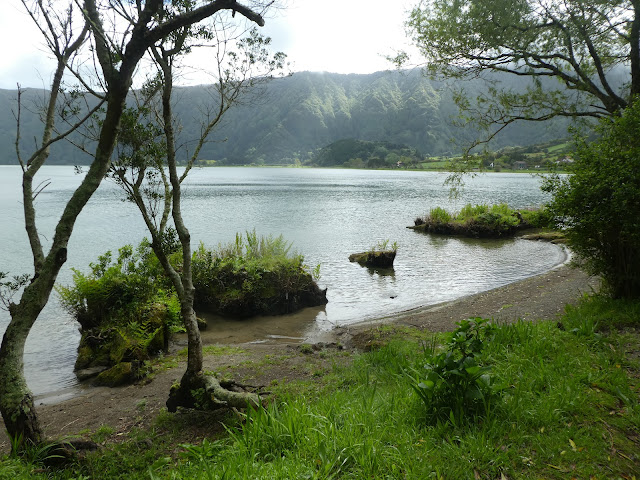











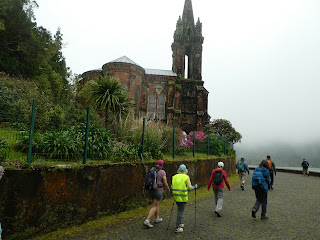

No comments:
Post a Comment